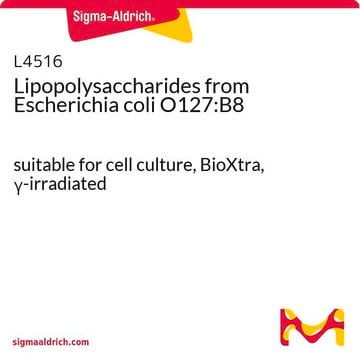L5668
Lipopolysaccharides from Escherichia coli O127:B8
Ready Made solution, 1 mg/mL
Synonym(s):
LPS
About This Item
Recommended Products
biological source
Escherichia coli (O127:B8)
Quality Level
form
buffered aqueous solution
concentration
1 mg/mL
color
colorless to faint yellow
solubility
water: soluble
shipped in
wet ice
storage temp.
2-8°C
Looking for similar products? Visit Product Comparison Guide
General description
Application
Biochem/physiol Actions
Preparation Note
Other Notes
related product
Storage Class Code
12 - Non Combustible Liquids
WGK
WGK 2
Flash Point(F)
Not applicable
Flash Point(C)
Not applicable
Personal Protective Equipment
Certificates of Analysis (COA)
Search for Certificates of Analysis (COA) by entering the products Lot/Batch Number. Lot and Batch Numbers can be found on a product’s label following the words ‘Lot’ or ‘Batch’.
Already Own This Product?
Find documentation for the products that you have recently purchased in the Document Library.
Customers Also Viewed
Articles
Explore the structure, function, and diverse applications of Lipopolysaccharides. Discover their role in bacteria, serological specificity, and research potential.
Related Content
Lipopolysaccharide (LPS) is a major component of Gram-negative bacteria, important for microbiological research.
Our team of scientists has experience in all areas of research including Life Science, Material Science, Chemical Synthesis, Chromatography, Analytical and many others.
Contact Technical Service


